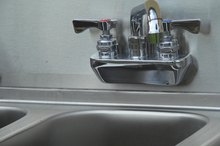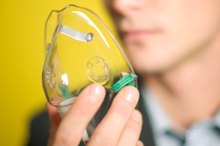How to Adjust the Airflow on a ResMed CPAP S6
The ResMed CPAP S6 is an older CPAP model that is still sold by some retailers. Unlike more recent CPAP machine designs, adjusting the prescribed air pressure on the S6 is not simply a matter of programming in a new pressure setting. Instead, the procedure requires the use of a number of specialized pieces of equipment. If you are a CPAP patient, you will need to have your pressure adjusted by a respiratory therapist. If you are a qualified respiratory therapist helping a patient with this ResMed model, the procedure for adjusting the prescription pressure is fairly straightforward and takes just a few minutes.
Connect the air tubing to the CPAP machine, but do not connect the mask.
How to Adjust Pressure on a Respironics CPAP Machine
Learn More
Connect any accessories the patient might normally use, such as a humidifier, filters or supplemental oxygen.
Turn the air flow on by pressing the Start button, and let the CPAP machine warm up for 15 minutes.
How to Troubleshoot a CPAP RemStar Auto M Series
Learn More
Remove one of the access port plugs, found on the underside of the CPAP mask frame, and attach the sensor tube's Luer taper end into the port.
Fit the other end of the sensor tube to the manometer.
Turn the CPAP machine off by pressing the Stop button, and turn off the power switch on the back of the machine.
Connect the CPAP mask to the tubing.
Hold the Start and the 20 buttons down simultaneously with one hand, while turning on the power switch at the back of the unit with the other. Keep holding down the two buttons until they light up.
Block the opening of the CPAP mask with the palm of one hand.
Read the pressure reading on the manometer. Press the 5 button on the CPAP machine control panel to decrease the output pressure or the 10 button to increase it, until the monometer matches the patient's prescribed CPAP pressure.
Press the Stop button to return the machine to normal operating mode.
Tips
ResMed makes a Blind Bubble Cushion that replaces the regular cushion on the CPAP mask to block the air flow. Using it will free up one of your hands as you set the pressure.
ResMed S6 Lightweight models have a fixed power cord rather than a power switch in back. To initiate the pressure adjustment mode, you'll need to unplug the unit and plug it back in while holding down the Start and 20 buttons.
Warnings
Patients should not attempt to adjust their CPAP settings themselves. Correct settings can only be determined through a sleep study in a clinical setting. Even if you feel you pressure is too high or too low, the problem may not be due to machine pressure, but may be due to the mask, humidifier or other factors. Setting a pressure that is too low will make CPAP treatment ineffective; setting a pressure that is too high may cause physical discomfort or injury.
Related Articles
References
- Cao MT, Sternbach JM, Guilleminault C. Continuous positive airway pressure therapy in obstuctive sleep apnea: benefits and alternatives. Expert Rev Respir Med. 2017;11(4):259-272. doi:10.1080/17476348.2017.1305893
- Konecny T, Kara T, Somers VK. Obstructive sleep apnea and hypertension: an update. Hypertension. 2014;63(2):203-9.
- ResMed Support.
- Philips Respironics Sleep Support.
Tips
- ResMed makes a Blind Bubble Cushion that replaces the regular cushion on the CPAP mask to block the air flow. Using it will free up one of your hands as you set the pressure.
- ResMed S6 Lightweight models have a fixed power cord rather than a power switch in back. To initiate the pressure adjustment mode, you'll need to unplug the unit and plug it back in while holding down the Start and 20 buttons.
Warnings
- Patients should not attempt to adjust their CPAP settings themselves. Correct settings can only be determined through a sleep study in a clinical setting. Even if you feel you pressure is too high or too low, the problem may not be due to machine pressure, but may be due to the mask, humidifier or other factors. Setting a pressure that is too low will make CPAP treatment ineffective; setting a pressure that is too high may cause physical discomfort or injury.
Writer Bio
Scott Knickelbine began writing professionally in 1977. He is the author of 34 books and his work has appeared in hundreds of publications, including "The New York Times," "The Milwaukee Sentinel," "Architecture" and "Video Times." He has written in the fields of education, health, electronics, architecture and construction. Knickelbine received a Bachelor of Arts cum laude in journalism from the University of Minnesota.









